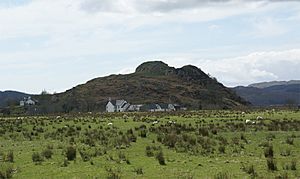Dunadd facts for kids
Dunadd (in Scottish Gaelic Dùn Ad, meaning 'fort on the [River] Add') is an ancient hillfort in Kilmichael Glassary in Argyll and Bute, Scotland. It was built during the Iron Age and early medieval period. Many people believe it was the main city of the old kingdom of Dál Riata. This kingdom appeared in Argyll in the early centuries AD, after the Romans left Scotland. The people who ruled Argyll at that time spoke Gaelic. Dunadd is a hill where they built a strong fortress.
Contents
What is Dunadd?
Dunadd is a rocky hill. It might have been an island a long time ago. Today, it is inland, close to the River Add. The fort gets its name from this river. It is a little north of Lochgilphead. The land around Dunadd used to be very boggy. It was known as the Mòine Mhòr, which means 'Great Moss' in Gaelic. This marshy land made the fort much harder to attack. Experts believe that Dunadd was an island or a point of land reaching into the water until later times. When sea levels dropped, the fort became easier to attack in the 6th and 7th centuries.
A Look at Dunadd's History
Dunadd was first used in the Iron Age. Later, it became a very important place for the kings of Dál Riata. It is famous for its special stone carvings. These carvings are found below the top part of the fort. They include a footprint and a basin. People think these were used in the Dál Riata kings' coronation ceremonies. This was when a new king was officially crowned.
On the same flat rock, there is a carving of a boar. This carving is in the style of the Picts. There is also an inscription written in the ogham script. Ogham is an ancient way of writing using lines and notches. This inscription is thought to be about someone named Finn Manach. It was likely made in the late 8th century or later.
Dunadd in Old Records
Dunadd is mentioned in old historical records. The Annals of Ulster record two important events. In 683, it says: "The siege of Dún At and the siege of Dún Duirn". A siege is when an army surrounds a place to try and capture it. The record does not say who was involved or what happened.
In the same records, for the year 736, it states: "Aengus son of Fergus, king of the Picts, attacked the land of Dál Riata. He captured Dún At and burned Creic. He also captured two sons of Selbach, named Donngal and Feradach." This shows that Dunadd was a key target in battles.
Dunadd's Later Importance
Even after the attack in 736, people continued to live at Dunadd. It was still used at least until the 9th century. Later records also mention Dunadd, showing it remained important. In 1436, a person named "Alan son of John Riabhach MacLachlan of Dunadd" was made a seneschal. This means he was a kind of manager for the lands of Glassary. The MacLachlan family lived near the fort.
In June 1506, important people met at Dunadd. They were sent by King James IV. Their job was to collect money and settle arguments between families.
Today, Dunadd is an Ancient Monument. This means it is a protected historical site. Historic Scotland looks after it. The site is open to the public all year, and there is no charge to visit.
What We Found at Dunadd
Because Dunadd is mentioned in old writings and is easy to find, people have dug there many times. These digs are called excavations. They happened in 1904–05, 1929, and 1980. Dunadd has some of the most important finds from any early medieval site in Scotland.
The items found date from the 6th to the 8th centuries AD. They include many different things. Workers found tools and weapons. They also found quernstones, which are stones used for grinding grain. There was also pottery that came from other countries. Other finds include special pieces used to make designs and moulds for creating beautiful metalwork, especially jewellery.
Dunadd in Stories
Dunadd has also appeared in books. In Rosemary Sutcliff's 1965 novel The Mark of the Horse Lord, Dunadd (called Dun Monaidh) is central to a struggle for royal power. The book even describes a royal crowning ceremony using the carved footprint.
Dunadd is also the setting for Claire R. McDougall's novel "Veil of Time". In this story, a modern woman travels back in time to Dunadd's busiest period in the 8th century. All the famous parts of Dunadd, like the footprint, the boar carving, the well, and the old ruins, are part of the story. The modern farm and houses nearby are also mentioned. Other ancient sites in the Kilmartin Valley also play a role in the book.
Images for kids












